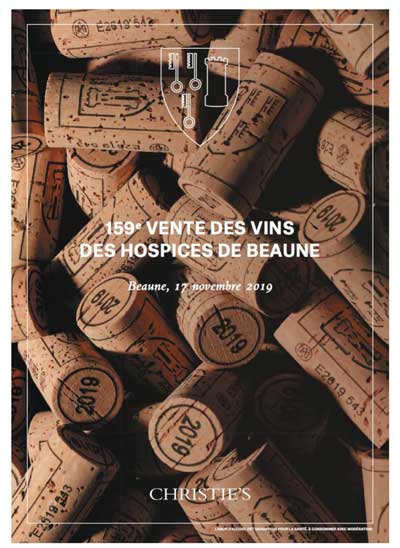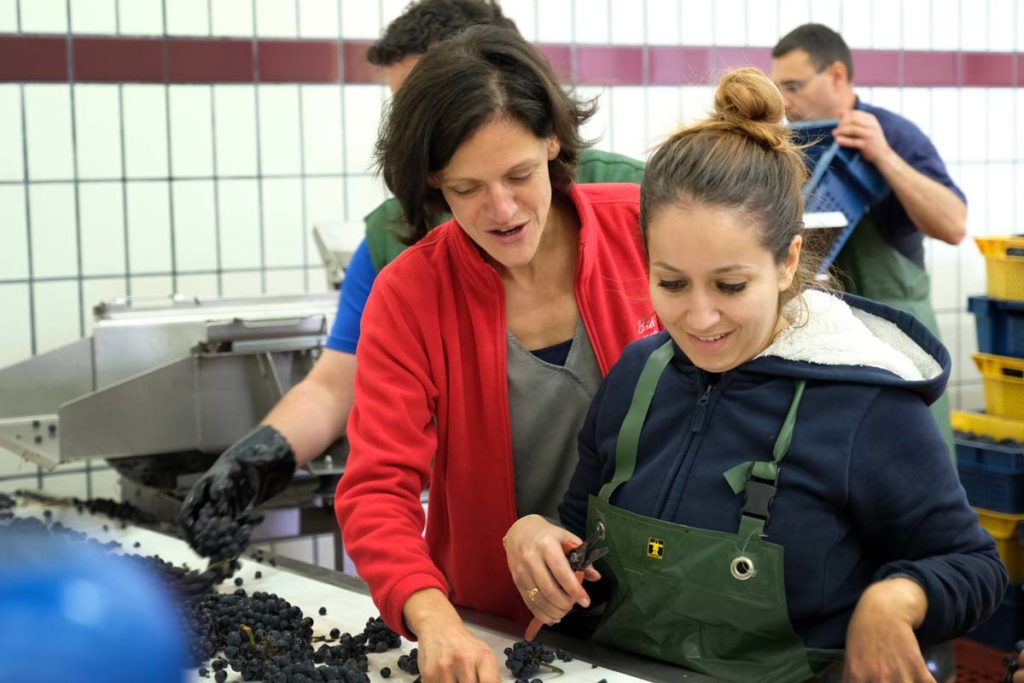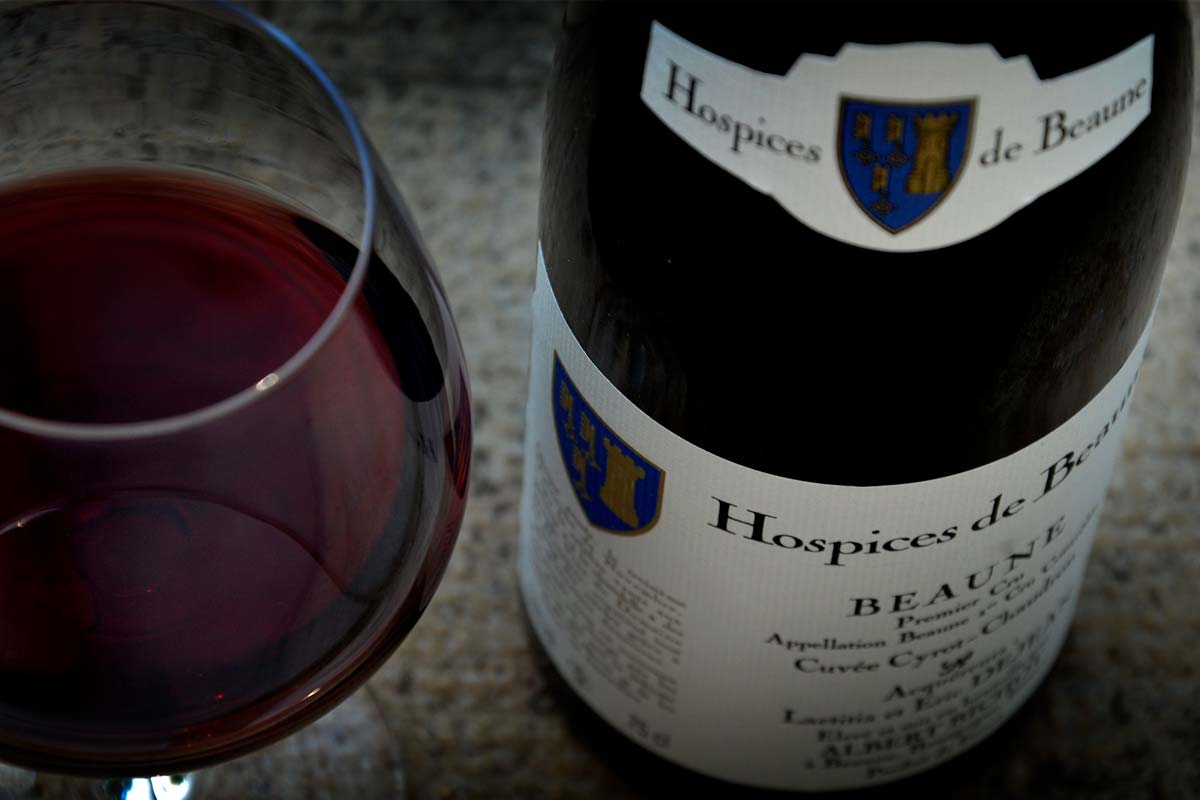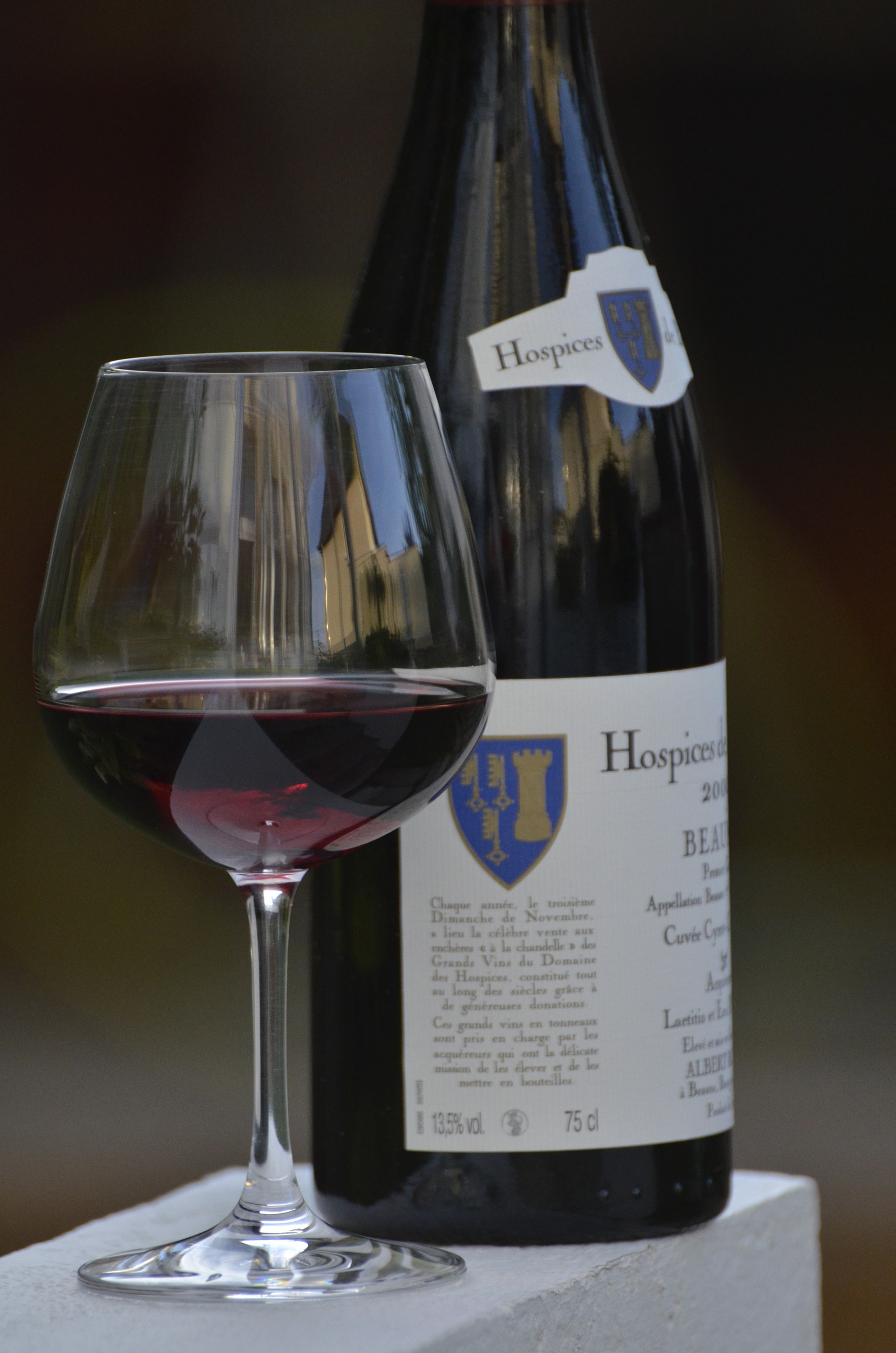Hospices de Beaune estate vintage 2019: solar and typically Burgundian
Domaine des Hospices de Beaune 2019 vintage: the year’s conditions, Ludivine Griveau’s winemaking

SUN & BURGUNDY: THEY HAVE SAID YES in 2019 declares Hospcies de Beaune winemaker Ludivine Griveau
The 2018 post-harvest sky struggled to recover in the autumn-winter period. Indeed, unlike the previous year, the rainfall deficit was already apparent in December and January. The difference between areas was already emerging: while Vosne-Romanée was only 6 mm away from normal, Chassagne-Montrachet was under by 100 mm at the end of March. There was a water shortage of 50% to 70% in January and February, which amounted to roughly 280 mm instead of 360 mm.
This unusual precipitation was combined with extremely mild temperatures: the autumn-winter period was almost 3°C above normal, which was the highest in the last 25 years. It wasn’t until January that we felt the bite of a few days of frost (about ten), but they were not consecutive and hardly went below -5°C.
The vine pruning thus took place under sunshine that was 140 hours in excess over the seasonal norms.
Once again this year there were very few days with negative temperatures; there was no real winter. By the end of March, the vegetation had already gotten so much sun that we could foresee an early start for the vines.
The cold weather at the beginning of April offset this and considerably slowed down the vines’ growth. We could barely sleep on the night of 5 April since the frost was looming…
It was -3°C starting at midnight and lasted over six hours along with high humidity… What we’d initially thought was a spring frost was actually a black frost, and the damage was very mixed depending on the extent of the growth cycle. Add this to the disparity in precipitation (depending on the plots) and growth (on the same branch), and you can understand how hard it was, at this stage, to gauge what the damage would be to the future harvest. Another frost expected for 14 April led to unprecedented preparations: all along the slope, from Chablis to Macon, candles were burning, fans were running and hay bale smoke screens were permitted (by ministerial order). As the water context was weaker than before, the damage caused was not very serious.
As for precipitation, it was significantly higher than normal, while the sunshine and even, paradoxically, temperatures, remained close to seasonal averages. It wasn’t until the last ten days of April that beautiful spring days warmed the atmosphere and growth resumed. Representing a shift, 2019 was one of the latest vintages because, with all these hazards, growth slowed down considerably.
In May, the vines had trouble growing: barely one leaf every six days during the first few weeks. Temperatures were abnormally cool, and it wasn’t until the middle of the month that the average temperature reached about 15°C. The temperature was low, but so was the amount of rainfall. May also had deficient rainfall, with only 40 mm instead of the average of 90 mm.
While there was no shortage of sunshine, cool temperatures prevailed. The late trend of the vintage amounted to a delay of about 20 days compared to 2011 (the earliest vintage of the decade). June was a month of contrasts! The first few days were very hot without rain. The temperature in Côte de Beaune even exceeded 30°C on Sunday, 2 June. Despite the low availability of water in the soil, summer was setting in. Rainfall was once again quite uneven from one area to another. The vines turned green again and the first signs of flowering were detected the first weekend in June.
As the Chamber of Agriculture reported on 12 June: “Flowering is already well under way”. Despite some chilly mornings (9°C in Hautes Côtes), the month ended with considerably more sunshine than the average (+53 hours).
In mid-June, once again, rainfall was the main factor: while it was overall in the normal range this month, several times there were heavy downpours, such as in Savigny, sometimes bringing 25 mm in one hour. This made it difficult to manage ploughing and using the tractors. On average, flowering ended as best it could around 18 June along the slope. It had become so variable due to the erratic weather conditions that by 25 June it was not uncommon to see, on one root, berries already forming next to barely sprouted blossoms!! A big headache at harvest time? Too early to say, but the question would surely be in the back of our minds!
The last two weeks of June were extremely hot, culminating in a heat wave from 26 June to 1 July: 39°C in the shade and an average of 28°C over seven consecutive days. Light rain around 21-23 June was enough to stimulate active growth of the vines; they appeared strong and resisted this heat wave incredibly well. If it’s necessary to highlight the huge temperature differences over the month of June, just note that it ended only slightly warmer than normal!
July was hot, almost 2°C warmer than normal. The heat came in waves; while the vines initially tolerated it rather well and continued to grow, the first symptoms of drought were visible on the young vines around 16 July. It was hot (more than 80 extra hours of sunshine), to be sure, but also dry. Rainfall alerts constantly appeared in our memos from the Chamber of Agriculture, indicating a water deficit of over 110 mm since January and 140 mm since October – which was about 45% of the norm since April. The little rain we got came in the form of storms, sometimes heavy ones, and we had two hail storms: on 7 July at Savigny and Chorey, and on 14 July at Corton Hill. Not as bad as feared, but still between 10% and 15% of the harvest was lost. The totals varied, but the heavy rains of 27 and 28 July nevertheless salvaged the crops. Finally, the veraison started ramping up. We already had the feeling that the vintage might not be so late after all: the Hospices de Beaune grapes might well be ready for harvest around 10-12 September instead of 15-20 September as had been expected at the end of flowering. To be determined!
In the first ten days of August, the weather was more seasonal, with bearable temperatures at last (18-26°C). Between 5 and 19 August, it started raining again and the berries could finally grow some more! By 20 August, the Pinot Noir grapes were now getting red, while the Chardonnay was gradually turning golden. The wind helped us out as it did a good job of drying the leaves between each rainfall. With temperatures rising again to summer levels around 25 August, the grapes were ripening rapidly: the “delay” was then only 10-12 days compared to 2018. Incidentally, the variation in the growth cycle observed since flowering held firm, and would continue until the week before harvest! Overall health was excellent on all our plots. There was no other option but to wait and begin to check for ripeness.
Sunshine in early September beat records and rainfall was once again lacking. By 4-5 September, we were now certain that 2019 would not be too late, and we were ready to start harvesting because the grapes were ripening in increments of 1% to 2% (v/v) per week. Even if the vines were protected, the first signs of water strain began (only just now!) to appear: some berries withered and some leaves turned yellow. Nevertheless, the vines remained strong and the grapes were getting tastier and tastier.
There’s never been a year whose climate was harder to sum up than 2019! By listing all the climatic events that the vines had to withstand in one year, we realise even more just how incredibly resistant these plants have been. We can bet they’ll need a good winter to recover.

Growth cycle
The first signs of new growth were observed in late February to mid-March. After a very mild stretch, on 25 March the bud break stage was reached. There were even some green buds here and there in young vines or in early areas (closed, etc.). On 1 April, it was not uncommon to already be 10 to 12 days ahead of the average bud break date, but the cool weather returned and slowed this trend down sharply. The nights of 5 and 14 April gave us a fright, with temperatures of -3°C on young leaves – all over a much longer night span than a “classic” spring frost. The vines took a hit. Growth slowed down considerably. There was no new growth from about 6 to 17 April, as if the plants had become dormant again. It wasn’t until the mild temperatures of 20-25 April that we began to see signs of recovery, with the first two to three leaves growing. We could already observe major variation in the growth cycle, not only within the same plot, but also on the same vine!
At the beginning of May, leaf growth became denser; at last the region was turning green. Chardonnay grapes had four to five leaves growing and Pinot Noir only three to four. This was also when we began to closely monitor mildew because, up to this point, it had not yet appeared.
Starting on 15 May, the sunshine enabled regular growth to resume, and we could finally start our vine work:
The small budding branches on the roots were removed. So were the double buds, in order to promote uniform leaf density later on.
This year, bud removal was moderate. These decisions by the manager in consultation with the team were based on careful observations of each plot: as soon as the inflorescences emerged, we could estimate a moderately good harvest at this stage; the load regulation by bud removal therefore had to be done carefully and on a case-by-case basis. It should also be noted that, at that point, the vines were still not very robust and remained a fairly pale green for the season. In early June, the vines gained strength and started growing, with the first flowers visible around 2-3 June in the earliest areas (Volnay Premier Cru Les Caillerets) and in the most uniform vineyard plots in terms of the growth cycle (Pommard Premier Cru Les Épenots).
The high temperatures at the beginning of the month caused the shoots to grow longer, but did not affect the size of the grape bunches! By the end of the first ten days of June, flowering was well under way. We then counted 13 leaves growing at this stage, and our visits to the vineyards were filled with scents of Chardonnay flowers.
During the same period, we performed the first lifting of the branches, in order to prepare for the vine training and subsequently guarantee perfect arrangement of the branches, fruits and leaves. Rainfall, often in the form of heavy downpours, led to increased growth of the side shoots that overtook the trellises. A long and meticulous leaf-stripping process then began in mid-June: the grapes would then have time to acclimate to the sun if necessary. The procedure was straightforward: we removed the side shoots in order to air out the vegetation, plus a few leaves if necessary. However, the plant cover needed to be left in place enough to maintain its “shield” and/or “umbrella” effect.
In addition, fertilisation, which has been organic throughout the winery since 2016, was all the more effective because it was better targeted around the fruit. This preventive approach was of great help in the fight against powdery mildew, which considerably affected the leaves this year.
So in mid-June the flowering was nearing its end and simultaneously signalling the variation in the growth cycle: by 20 June, the Volnay Premier Cru was already at fruit set while the Beaune Premier Cru Bressandes was only at the cap-fall stage. Coulure was seen as quite significant in all areas. We feared for our yields because the turbulent weather at the end of flowering had in a sense disrupted the fruiting process.
Late June to early July took a completely different turn: the heat wave, with favourable humidity, allowed for explosive growth. This year there was a lot of wind, which weakened the branches: they had to be stapled firmly down. Trimming was done carefully to avoid shrivelling. Despite the overwhelming dry heat, the grapes grew visibly and it was not uncommon to see bunch closure by 5-8 July.
Every passing day, we got the sense that the differences in growth cycle were blurring and that the uniformity between the plots was on the rise. However, it was not unusual to observe many poorly formed grapes and millerandage – a sign of modest yields. The summer rain would be decisive, so we kept an eye on the sky.
Fortunately, the damage caused by the hail storm of 7 July at Savigny and 14 July at Corton was limited.
The leaves were not torn off and the grapes were only moderately affected. In any case, there was nothing we could do – only the wind and sun that followed would help the grapes dry and heal.
In mid-July, the bunches were closed, but it was hot and dry: the first yellowed leaves appeared on the youngest vines, but the rest were fairly resistant and the leaves remained a shiny dark green. Growth, while slower, did not prevent the plant cover from doing its job, and the first green berries appeared around 22-25 July. We then began to seriously rethink the lateness of the vintage, as the harvest date seemed approaching sooner than originally thought.
The week of 20-25 July was a scorcher, the second heat wave in sight. We limited trimming and ploughing in order to avoid the phenomenon of shrivelling; we welcomed the rain at the end of July as a blessing! It had the twofold advantage of effectively and dramatically triggering the veraison, which was just waiting for the right moment to happen.
As the veraison progressed (from about 5 to 22 August), the health risks decreased, as did the plants’ vulnerability to disease. Although there was virtually no mildew this year (due to lack of water), powdery mildew was rampant. Organic cultivation was a success: the Hospices de Beaune’s vines were healthy and beautiful. The fruits were slowly bursting with colour and sugar, and the leaves, which were very green, effectively performed photosynthesis. The sun and wind helped to concentrate the sugar as well as the acid; this was very reassuring, and all we had to do now was wait.
Starting on 27 August, we began checking for ripeness, which confirmed the major variation of this vintage. More than ever, scrutinising each plot would be crucial for making the right decision about when to harvest. And so Pommard is earlier than Beaune!? Volnay remained true to form with its early nature. But to drive the point home, Côte de Nuits was ripening faster than Corton!!! This time, there would be no doubt, the decision about when to harvest would be a challenge, and would really require us to keep our cool!
So we decided:
1 – To not rule anything out: after all, if Corton had to wait…
2 – To sample all the grapes: the Pinot Noir skins were top-notch.
3 – To analyse the juice: acidity was stable – good news!
4 – To decide: and let’s go!
So we harvested earlier than expected: on 6 September in Chaintré for the Pouilly Fuissé; then starting on 9 September for the Côte d’Or Chardonnay, which grew even faster than the Pinot Noir at the end of the cycle. The reds arrived in the vat room on 12 September – Volnay and Pommard kicked it off!
The red grapes were almost perfectly healthy – they were delicious, with crisp skins and intense flavours. For Pinot, only the dry grapes were carefully sorted, and within 12 days, the 60 hectares were harvested. The colour and tannin extraction from the skins was optimised and actually facilitated by their fine ripeness. Intense fruity aromas permeated the vat room during fermentation and until the vats were emptied.
The Chardonnay was fruity and very sweet, almost syrupy, but still with incredible acidity! The perfect vintage here too! All wines, both white and red, fermented without any problems, despite the sometimes slightly high alcohol levels, which in no way hindered the fermentation process.
The preserved acidity (despite the high sugar content) seems to be the unifying feature of this vintage, which is superb in both red and white. That’s why we can be satisfied to have a “very Burgundy vintage” despite its also very “sunny” aspect. Here’s to a great pairing between the sun and Burgundy!
Buy at the next Hospices de Beaune wine auction: Albert Bichot is at your side, from 1 bottle to 1 barrel.

Buy from just 1 bottle at the Hospices de Beaune auction
5 WINES SELECTED BY ALBERT BICHOT.
EN PRIMEUR PURCHASE
Buy online our selection of Hospices de Beaune old vintages
Every year, Albert Bichot buys a selection of barrels from the 50 Hospices de Beaune wines. We age them to perfection and then bottle them. This is why today our online store is the best place to buy the outstanding Hospices de Beaune wines back vintages.
Due to limited quantities and logistics issues, our online store displays only a selection of our Hospices de Beaune and Nuits-Saint-Georges back vintages. Please do not hesitate to contact Jean-David by email to receive the full listing. We can ship in most countries!

